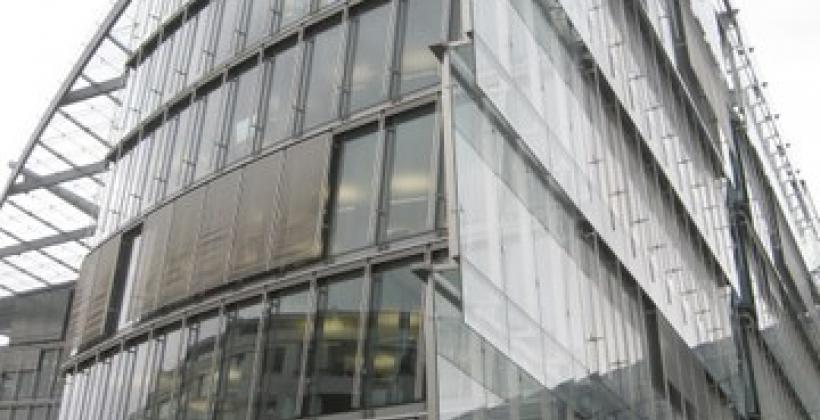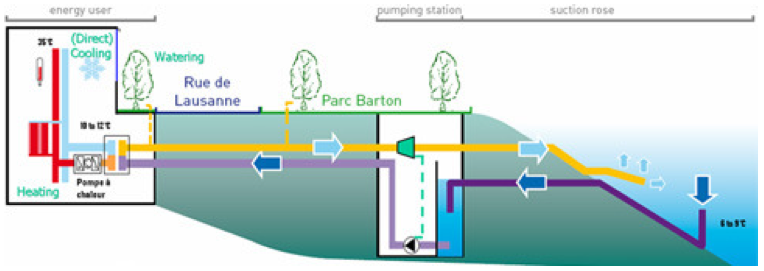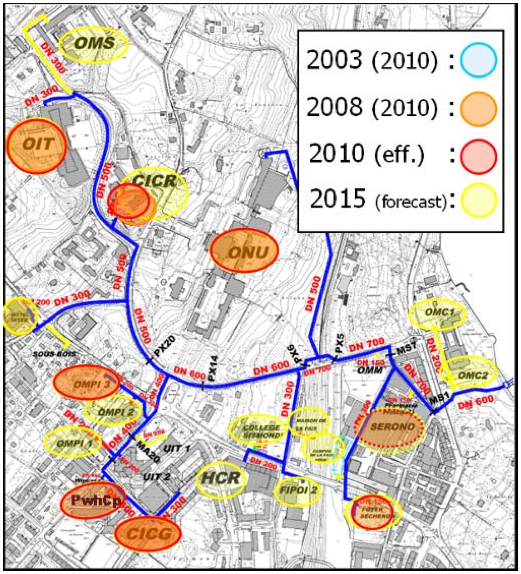
Location
Description
One of the first principles of sustainable living is to make the best use of the resources that are closest at hand. Genève is putting this principle into practice using a resource that is right at its doorstep: the water of Lake Genève. The lake´s water – nearly 90 km3 in volume – has a conveniently constant temperature of eight degrees Celsius on the ground. This makes the water an ideal source of energy for heating and cooling buildings of Switzerland´s second largest city.
The project TetraEner is refurbishing seven buildings and constructing five more to take advantage of this renewable energy source. The existing buildings are located in the Genève-Lac-Nations district and include offices of the United Nations, the International Labour Organisation and International Committee for the Red Cross. New buildings will include residential units, offices and a school.
Documents
Site facts and figures
- Estimated population involved: 14,000
- Approx. geographical area coverage: 368,000 m²
- Approx. energy saving: 25% reduction in conventional energy consumption
- Approx. energy from RES: 20%
Technologies
Technologymix
Within the scope of CONCERTO the „Geneve Lac Nations“-project (GLN network) is supported. Purpose of the project is to connect buildings at the “Sécheron-Nations’ District” to a thermal hydraulic network for supplying heating and cooling energy as well as just water for plant watering needs.
The network uses water of the lake Geneva, which is pumped from a depth of about 35 m in order to have a temperature sufficiently constant and low (ca. 6 to 9°C throughout the complete year, Figure 1). This water then circulates within the GLN network, which connects the pumping station in the lake to the various customers' sub-stations by pipes with a total length of about 6 km (Figure 2). Cooling is performed by direct cooling or, if secure supply or lower temperatures are required, by connecting traditional chillers. Heat pumps are implemented to move the temperature up to a heating level (see “More detailed”).
Furthermore eleven new eco-buildings are constructed and will be connected to the network, summing up to 200,000 m² of residential, administrative and other tertiary floor area. One of them is the “Sismondi’s College” building (Picture 1). Ten of the new buildings connected to the network will be certified “Minergie” (swiss label for very low energy demand). Existing buildings are retrofitted to suit the standards for connecting to the low energy heating and cooling grid.

Figure 1 – The monthly temperatures of lake water in different depths

Figure 2 – Functional scheme of the primary and secondary networks
The “Genève Lac Nations” (GLN) Network
The total flow in the network accounts to 2,700 m³/h and thus offers a theoretical cooling power of 16.2 MW. Picture 2 shows the structure of the suction plant, which will be located under water. Modelling and simulation has been performed to find the best spot in the lake for pumping the water from (3D CFD) and to predict the possible connecting power of consumers in the district (Figure 1). The system also enables various gardens in the district to use water from the lake for watering, instead of using potable water as before. Thereby 75,000 m³ of high quality potable water can be saved annually.
Cooling service is realized through the use of simple heat exchangers directly connecting the internal (i.e. secondary) distribution system of the building to the network, providing about 90 % of the total cooling demand per year. If the cooling power has to be secure and stable or if cooling is needed at low temperature level, a condenser of a classical chiller can be serially connected to the network, resulting in an improved global efficiency of the machine. Providing heat to the new (eco-) buildings is realized by the use of high-efficiency heat pumps, which increase the temperature of the secondary system to 35 - 40°C. The temperature level is 55°C if there is also need of domestic hot water preparation, resulting in a lower coefficient of performance. Watering of the numerous gardens in the area is also made possible by taking water from the return pipes of the GLN network.
Since the start of the project some slight adaptations at the pumping station’s flow-rate metering system have been made. Apart from this the network runs without major problems, 4 (big) customers are currently connected (existing buildings, representing about half of the theoretical cooling power). Figure 2 shows the extension plans for the network until the year 2015.

Figure 1 - Simulated heating energy demand in the district at the ambient temperature of -6°C

Figure 2 – The predicted network scheme for 2015, showing the future connections in yellow
Lessons learnt
The following information has been gathered as part of the CONCERTO Premium policy research.
Benefits of CONCERTO:
Key benefits:
- Approximately energy saving: 25% reduction in conventional energy consumption. Approx. energy from RES: 20%.
- The tariff studies ended by an innovative tariff system implemented
- The project generated know-how concerning the use of hydrothermal network. At a technical level, monitoring has shown that the project objectives have been achieved.
Skill development:
There were 3 training activities:
- training regarding district heating in urban
- know-how concerning the use of hydrothermal network implemented within the project which has been passed on to 10 people
- lectures for students.
Local economic effects:
Two new positions of employment were created within the TetraEner project.
Barriers encountered:
Administrative barriers:
Reporting demands from the EC were seen to be very labor intensive and time consuming. Spanish partner and coordinator San Sebastian dropped out, as their projects were not eligible any more. There was very little contact with the observer communities. The methodology part of the project was run in parallel with actual planning and implementation, rather than preceding it.
Technical barriers:
Energy from Lake Geneva had initially been intended to be used for heating, not just cooling. This was not found to be economically viable by the local energy company. Therefore, the lake was only being used for cooling.
Social barriers:
Resistance and fear to changes. Communicating with owners and technical staff of the buildings concerned was one of the main challenges, as conservative options prevailed and there were worries about the costs involved. Therefore, the quality of information and a general need to communicate was important. Need to have some "lever" actors (e.g. one important consumer, such as UNO) and some federative elements.
Success factors identified:
Technical Success Factors:
The CONCERTO project in Geneva developed a simulation model called ENERGIS that evaluates energy needs in a district on the basis of a statistical analysis that uses statistical energy values or real energy data if existing, relying on several characteristics of the buildings (age, structure, occupancy) that are inside a districts.
Social Success factors:
Quality of information and general need to communicate (first to convince the future customer to "enter" the project, then to enhance user's behavior), the need to have some "lever" actors and some federative elements. Also, communication campaigns and training activity have been determinant for considering Lake Geneva as a natural resource for city’s sustainable development.
Institutional success factors:
Architect and Engineers have to work together from the outset since they have to provide an energy concept before receiving the building permit. These include the obligation, for large energy consumer projects to submit an energy concept that should be approved by the cantonal energy service. Possible synergies with other buildings in the neighborhood can then be more easily identified and exploited. Furthermore, large existing buildings with high energy consumption were obliged to report to the authorities annually, providing an energy performance index that enabled the detection of any deviation from plan. Geneva's Canton also provided financial tools to develop the implementation of sustainable energy systems, such as a guarantee fund in order to facilitate the realization of “risky” projects.
The presence of the Geneva Energy Department “SCANE” as coordinator of the CONCERTO project, with a strong involvement & support was determinant for speeding up administrative procedures and involving the private sector by taking all the financial risk.
Economic success factors:
- Importance of economic aspects (green solutions are not sustainable if not economically efficient)
- The rather innovative instrument/procedure, called the “district energy concept”, facilitated the process by grouping architects, engineers and policy makers before the planning phase, identifying the key questions and possible barriers, and generating useful technical information for the following land planning procedure
- Public-private partnerships and a risk guarantee fund offered by the canton
Other:
Geneva Cantonal energy policy was considered to be a real driver for the uptake of the CONCERTO project. It was formalized in two documents, the “Conception générale de l’énergie” - general energy concept - which defined the objectives, the energy targets and is the guideline for the whole energy policy in Geneva, and the “Plan directeur cantonal de l’énergie” - energy plan for the Canton- which was the operative part of the CGE. The State Council adopted the Energy Plan Scheme for the canton, Geneva 2010-2015 (Plan Directeur cantonal de l’énergie), which describes the measures to be used in order to reach the first step toward the 2000 Watt society without nuclear.
Business models used:
Municipal utility companies were covered by the public sector of energy supply companies. They were present in Geneva. The local utility company in Geneva was a key project partner. This enabled necessary investment in parts of the energy system infrastructure. There was also a financial tool, the risk guarantee fund offered by the canton that enabled the local utility provider (main demonstration actor) to invest in infrastructures when the guarantee of success was not really clear.
A SWOT analysis was carried out to find the most suitable business form. At the end of this process, the so called “Sole Partnership” was chosen for various reasons. This option implied that the whole project was under the control of the Geneva’s Industrial Utilities (SIG), a 100% public owned utility. During the construction phase, it has been opted for an outsourcing solution (e.g. installation and maintenance) while the operation of the plant was in the sole responsibility of SIG. This solution has been chosen for various reasons. One of them being that SIG is a public company and therefore financial risk is guaranteed by the state. It was possible to implement this solution without major legal or regulatory problems and also financing could be solved through this public-private partnership model. Additionally, studies have been undertaken to find an appropriate and innovative tariff system and steer rational energy consumption behavior. Attractive tariff systems coupled with information, involvement and training of potential customers were determinant for success and the network presently has used all available cooling potential. Other communities showed interest in the technology, organizational and financial solutions
Legacy – follow-on projects:
The project has had a certain "impact" as at least two similar projects were initiated on lake Geneva and because many people from various European countries asked for information – one is called GENILAC.
Legacy - Policy Developments:
The experience of CONCERTO was, together with other exemplary projects, a source of inspiration for the new energy law. Geneva Canton transposed some successful CONCERTO results into regional ordinances with massive replication effects.
A new law definition of territorial energy concept outlines containes following statements (consequence of CONCERTO demonstration experience articles 6-12).
The CONCERTO approach
The backbone of the Geneva CONCERTO project is a low-temperature thermal exchange network that will use water from Lake Geneva as a heat source/sink which remains at a nearly constant temperature of 8ºC near the ground. The use of this specific network, combined with an intelligent design or adaptation of the connected new and/or existing buildings, enables the district to develop a highly efficient production and conversion system for heating and cooling (esp. due to direct cooling). Consequently, existing buildings from Geneva's community will reduce their electrical consumption for cooling purpose by about 50% and new ecobuildings will achieve at least 30% energy reduction compared to National Buildings Standards.
The main components of the network are:
- a water pumping station, (including a system on the return line which recaptures hydraulic energy to drive the pumps, resulting in reducing energy needs for pumping).
- the water distribution network that extends five kilometers inland from the lake through a previously developed region of Geneva.
- sub-stations for each supplied buildings including heat pumps (for heating) and/or heat exchangers (for direct cooling).
- thermal heating capacity is about 3 MW and the thermal cooling capacity of the network is 16.2 MW
Thematic Field
- New Building(s)
